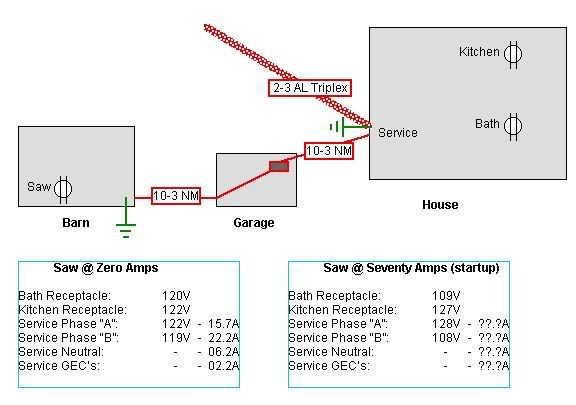- Location
- Windsor, CO NEC: 2017
- Occupation
- Service Manager
My dad bought a new table-saw from Harbor Freight, put it in his barn, turned it on and the fluorescents in his barn went into strobe mode. The next time I came by he asked me to took me out there to look at the situation and solve it.
Study the following diagram and discuss:

The plot consists of a 190x-built brick house with a 100A service. I could not inspect the terminations behind the meter socket (sealed), or the terminations at the drip loops at the top of the mast.
There is a conduit running underground from the service to the detached garage. The conduit enters the garage, enters a small 2-space panelboard with two 15A branch circuits for the lighting and receptacles in the garage. Conduit leaves this panel and crosses the ceiling, drops down the other side, exits the garage and runs underground to the barn.
In the barn there is a panel with four breakers. One for the loft, one for the main floor lights, and two for general purpose receptacles.
The saw's nameplate says "120V 22A" and the owner's manual calls for a 20A circuit. It has a standard 15A plug configuration. At startup, the saw draws 70A, and settles down to 5.5A running under no physical load.
Now, to my questions:
I plan to install a new 60A feeder to the barn (directly), and install a new 3R panelboard to comply with 110.26 (the existing one is over a workbench with a toolbox screwed down in front of it). I intend to rewire the main floor to get rid of the extension-cord permanent wiring of the lights. That's for starters.
Thanks in advance for all replies, and sorry for it being so long.
Edit to add: The voltage at the saw receptacle when the saw starts drops to 90V. The lights are on the opposite phase and still flicker. I am uncertain of the voltages at the barn before/during the saw startup. (Another disclaimer would be that I wrote down these voltages after I got home, not when I was taking the readings. I also did not verify phases of each testing point, but made assumptions based on the readings as to which phase a testing point was on.)
Study the following diagram and discuss:

The plot consists of a 190x-built brick house with a 100A service. I could not inspect the terminations behind the meter socket (sealed), or the terminations at the drip loops at the top of the mast.
There is a conduit running underground from the service to the detached garage. The conduit enters the garage, enters a small 2-space panelboard with two 15A branch circuits for the lighting and receptacles in the garage. Conduit leaves this panel and crosses the ceiling, drops down the other side, exits the garage and runs underground to the barn.
In the barn there is a panel with four breakers. One for the loft, one for the main floor lights, and two for general purpose receptacles.
The saw's nameplate says "120V 22A" and the owner's manual calls for a 20A circuit. It has a standard 15A plug configuration. At startup, the saw draws 70A, and settles down to 5.5A running under no physical load.
Now, to my questions:
- Would it be compliant to install a dedicated 20A circuit for the saw?
- Why does the voltage increase in the kitchen receptacle when the saw starts up? Is this indicative of a resistive service neutral, or is this normal due to the capacitance of the neutral conductor?
- Why is there 2.2A flowing on the GEC's, even though the neutral current is seemingly correct for the loads measured on the phases? In my mind, the neutral should either be 4 or 8 amps: If 2.2 amps are coming into my service from neighboring services, then the neutral should be 8A. If the neutral current from my house is flowing into the GES (because of a resistive neutral), then the neutral current should be 4A.
I plan to install a new 60A feeder to the barn (directly), and install a new 3R panelboard to comply with 110.26 (the existing one is over a workbench with a toolbox screwed down in front of it). I intend to rewire the main floor to get rid of the extension-cord permanent wiring of the lights. That's for starters.
Thanks in advance for all replies, and sorry for it being so long.
Edit to add: The voltage at the saw receptacle when the saw starts drops to 90V. The lights are on the opposite phase and still flicker. I am uncertain of the voltages at the barn before/during the saw startup. (Another disclaimer would be that I wrote down these voltages after I got home, not when I was taking the readings. I also did not verify phases of each testing point, but made assumptions based on the readings as to which phase a testing point was on.)
Last edited:

